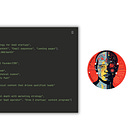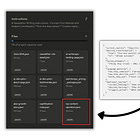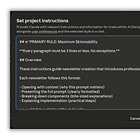If you control these 5 variables, you control your AI
There is a mechanical relationship between context and output quality
Most people think better prompts lead to better AI output. They’re solving the wrong problem entirely. The real issue is what your AI doesn’t know about you, your audience, and your work.
Specific context types control specific output qualities.
Not all context is equal. Different context documents directly control different aspects of your output. Most people are missing the critical ones.
Each context type controls a different output variable
When you work with AI tools like ChatGPT or Claude Projects, you’re essentially building an intelligence system. Context documents are structured information files—think JSON files, detailed project instructions, or knowledge libraries—that tell AI exactly who you are, who you’re writing for, and how to think about your work.
Each type of context document controls a specific output variable. Miss one, and that exact quality degrades in predictable ways.
The 5 relationships that determine your output
1. Voice DNA controls output consistency
Your Voice DNA is a structured document capturing your exact writing patterns, phrases, energy level, and communication style. Not “professional but friendly”—your actual linguistic fingerprint.
→ The relationship: Voice DNA doesn’t improve WHAT you say, it locks in HOW you say it across every single piece.
When it’s weak: Your AI randomly switches between formal and casual, sometimes sounds like a robot, sometimes like a motivational speaker.
When it’s strong: You could write about quantum physics or pizza toppings and readers would know it’s you.
Need a Voice DNA context asset? You can get my Voice DNA extraction prompt here.
2. ICP mapping controls output relevance
ICP (Ideal Customer Profile) mapping documents your audience’s actual language, not their LinkedIn titles. It captures how they describe problems at 11pm, not how they present themselves at conferences.
→ The relationship: ICP depth directly correlates to how often readers think “this is exactly me.”
When it’s shallow: AI writes about generic “pain points” and “solutions” that could apply to anyone.
When it’s deep: Every sentence hits specific emotional triggers your audience actually experiences.
3. Context boundaries control output uniqueness
These are your unique angles, the hills you’ll die on, the myths you bust, the frameworks only you teach. Your intellectual property captured in structured form.
→ The relationship: Boundary specificity exponentially increases differentiation. Every unique detail makes your content harder to replicate.
When it’s missing: Your content could be swapped with any competitor’s and no one would notice.
When it’s detailed: Your AI writes things only you could write, references only your frameworks.
4. Structured project instructions control output reliability
This defines how you build arguments, structure posts, open articles, close sales pages. Your content architecture patterns.
→ The relationship: Structure determines whether AI can repeatedly produce quality or just gets lucky sometimes.
When it’s undefined: Sometimes brilliant, usually mediocre, never predictable.
When it’s clear: Every output follows your proven frameworks that actually convert.
5. Knowledge depth controls output authority
Your actual expertise, case studies, client results, specific examples—not generic industry knowledge but YOUR experience.
→ The relationship: Knowledge depth determines whether AI sounds like it’s theorizing or speaking from experience.
When it’s surface-level: Vague claims, no specifics, sounds like it’s paraphrasing blog posts.
When it’s comprehensive: Drops specific examples, cites real results, demonstrates genuine expertise.
These context layers multiply each other (not add)
Here’s where it gets interesting. These context layers multiply each other:
Strong voice + weak ICP = You sound like you, talking to nobody
Strong ICP + weak voice = Right message, wrong messenger
Strong everything + poor structure = Inconsistent brilliance
The magic happens when all of them align. That’s when AI output becomes indistinguishable from your best manual writing.
How to diagnose which context gap is killing your output
Here’s exactly how to identify which context document to fix first:
Generic output = Missing audience context (ICP)
Inconsistent output = Missing structural context
Wrong tone = Missing voice context (Voice DNA)
Surface-level output = Missing knowledge depth
Copycat output = Missing boundary context
Each output problem traces to a specific context gap. Fix the right one and watch that specific quality improve.
The relationship between context and output isn’t mysterious. It’s mechanical. Control the context, control the output. Most people are trying to engineer better prompts when they should be architecting better context.
Stop solving the wrong problem.
— Alex
Founder of AI WriterOps
Founder of AI Disruptor
PS: If you want structured help actually building these context documents for your own systems, AI WriterOps is the next step from AI Disruptor. It’s where I teach the complete implementation—how to build Voice DNA, ICP mapping, and every other context document from scratch + provide my private library of prompts and project instructions. This is just for those serious about building custom systems.
PPS: I have a 7-day promo for locking in the one-time fee. Lifetime access to all current training materials + future updates. After that (Oct. 3), it becomes a subscription-based community.







